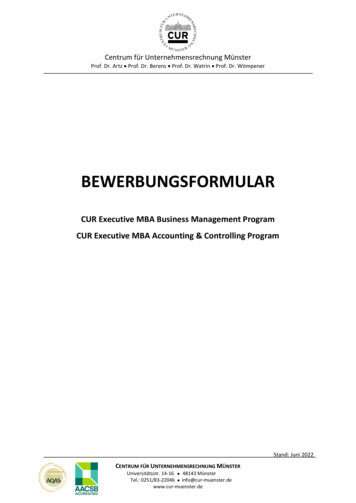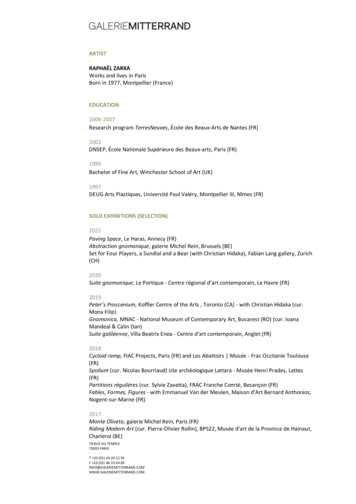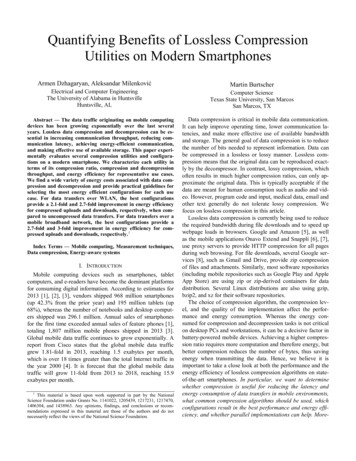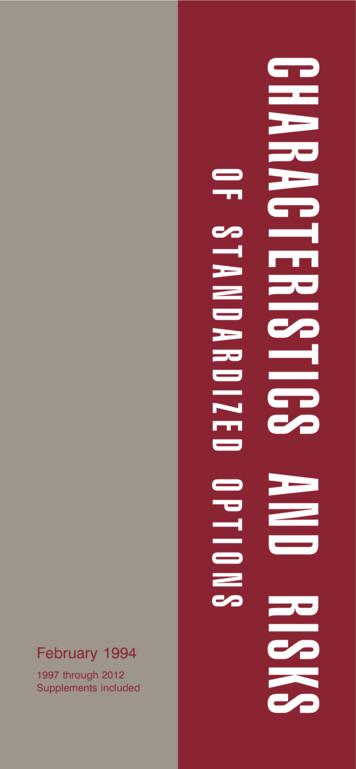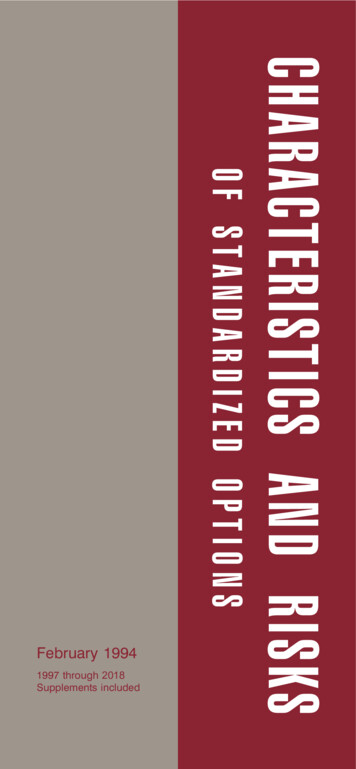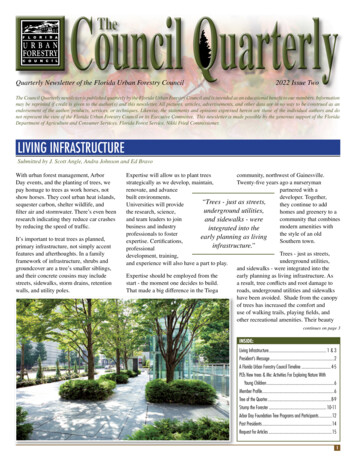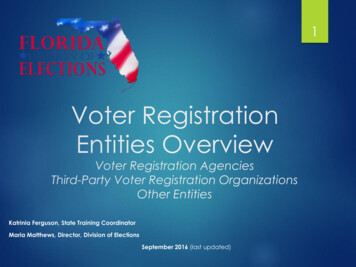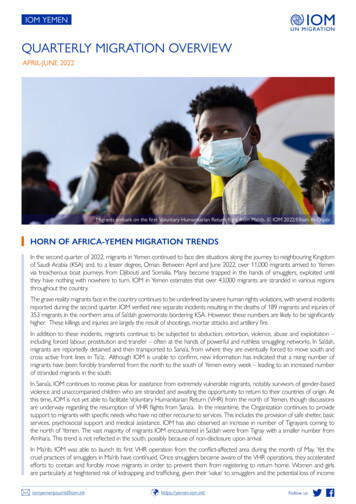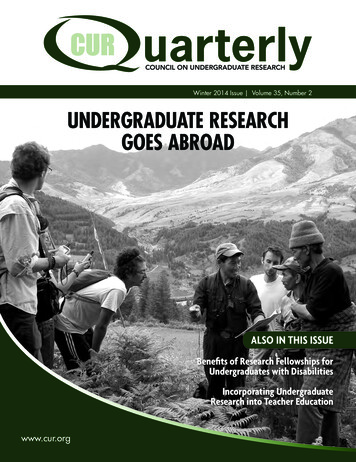
Transcription
uarterlyCOUNCIL ON UNDERGRADUATE RESEARCHWinter 2014 Issue Volume 35, Number 2UNDERGRADUATE RESEARCHGOES ABROADALSO IN THIS ISSUEBenefits of Research Fellowships forUndergraduates with DisabilitiesIncorporating UndergraduateResearch into Teacher Educationwww.cur.org
uarterlyCOUNCIL ON UNDERGRADUATE RESEARCHVolume 35, Number 2Editor-in-ChiefEngineeringJames T. LaPlant, College of Arts and SciencesValdosta State Universityjlaplant@valdosta.eduBinod Tiwari, Civil and EnvironmentalEngineering DepartmentCalifornia State University, Fullertonbtiwari@fullerton.eduIssue EditorsGeosciencesJanice DeCosmo, Associate DeanUndergraduate Academic AffairsUniversity of Washingtonjdecosmo@uw.eduStephen Heinemann, Department of MusicBradley Universitysjh@bradley.eduCopy EditorCheryl Fieldscheryl.fields@verizon.netTechnical EditorLindsay Currielcurrie@cur.orgFeature EditorsBook ReviewSusan Berry Brill de Ramirez, Department of EnglishBradley Universitybrill@fsmail.bradley.eduInternational DeskMick HealeyProfessor EmeritusUniversity of GloucestershireHealey HE ConsultantsMHealey@glos.ac.ukAlan JenkinsProfessor EmeritusOxford Brookes Universityalanjenkins@brookes.ac.ukUndergraduate Research HighlightsMarie GrafSchool of NursingGeorgia Southern Universityannennis@georgiasouthern.edu2014-2015 Divisional EditorsArts and HumanitiesD. Tulla Lightfoot, Department of ArtUniversity of North Carolina Pembroketulla.lightfoot@uncp.eduAt-LargeCarl Wozniak, School of EducationNorthern Michigan Universitycwozniak@nmu.eduBiologyLonnie Guralnick, Departmentof Mathematics & Natural SciencesRoger Williams Universitylguralnick@rwu.eduChemistryAlex Norquist, Department of ChemistryHaverford Collegeanorquis@haverford.eduLaura A. Guertin, Department of Earth SciencePenn State-Brandywineuxg3@psu.eduHealth ScienceNiharika Nath, Life Sciences DepartmentNew York Institute of TechnologyManhattan Campusnnath@nyit.eduMathematics andComputer SciencesBen Ntatin, Department of Mathematicsand StatisticsAustin Peay State Universityntatinb@apsu.eduPhysics and AstronomySorinel Oprisan, Department of Physicsand AstronomyCollege of Charlestonoprisans@cofc.eduPsychologyAmy Buddie, Department of PsychologyKennesaw State Universityabuddie@kennesaw.eduSocial SciencesLaurie Gould, Department of CriminalJustice and CriminologyGeorgia Southern Universitylgould@georgiasouthern.eduUndergraduate Research ProgramDirectorsSumana Datta, Department of BiologyTexas A&M Universitysumana@tamu.eduGraduate AssistantKhristian RobertsValdosta State UniversityPublisherCUR National OfficeCouncil on Undergraduate Research734 15th Street NW, Suite 550Washington, DC 20005-1013Phone: 202-783-4810Fax: 202-783-4811www.cur.orgDesignDesign and Prepress ProductionSliceWorksGaithersburg, MDwww.slice-works.comProduction and MailingThe Sheridan PressHanover, PAwww.sheridan.com/The Council on UndergraduateResearch Quarterly is publishedin the Fall, Winter, Spring, andSummer by the Council onUndergraduate Research.The mission of the Council onUndergraduate Research is to supportand promote high-quality undergraduatestudent-faculty collaborative research andscholarship.The Council on Undergraduate ResearchQuarterly and CURQ on the Web serve asthe official public “voice” of CUR to both itsmembers and to a broader community. Theirpurpose is to provide useful and inspiring information about student-faculty collaborativeresearch and scholarship from all disciplines atall types of institutions. The goal and functionis to advance the mission of CUR. To this end,the operation and editorial policies are flexible so that its content and deadlines meet theimmediate needs of the communities that itserves. The CURQ on the Web can be found atwww.cur.org/publications/curquarterly/.CUR Advertising PolicyThe Council on Undergraduate Researchaccepts advertising from organizations andindividuals if such ads are in line with ourtax-exempt educational purpose, which isto promote undergraduate research andeducation. We retain the right to refuse anyadvertising that we feel does not fall withinour guidelines.For more information, contact the NationalOffice at cur@cur.org or 202-783-4810.SubscriptionsFor CUR members, the CUR Quarterly isdelivered as a benefit of membership. Forother individuals, the annual subscription rateis 42. For libraries, the subscription rate is 87 annually.To order a subscription, visit: www.cur.org/publications.html.ISSN 1072-5830Council on Undergraduate Research734 15th Street NW, Suite 550Washington, DC, 20005-1013Cover Photo:SFS student directed research group members preparefor forest mensuration transect with members of thelocal community forest management group and a foresttechnician. Tang Valley, Bumthang, Bhutan. (Photo credit:The School for Field Studies)
uarterlyCOUNCIL ON UNDERGRADUATE RESEARCHCONTENTSWinter Focus:Undergraduate Research Goes AbroadFifty Years of Undergraduate Research in Europe. 7—Bill Campbell, Lissa Schneider-RebozoDeveloping U.S. Students’ Skills in Communication Research Through Ethnographies of Speech in DifferentLondon Settings. 14— Danielle LeekFostering Students’ Commitment to Service Through International Field Research. 20— Robin Sears, Laura S. MeitznerOther ArticlesFrom the International Desk: Student as Producer:Research-engaged Teaching Frames University-wide Curriculum Development.28—Mike NearyIncorporating Undergraduate Research into Teacher Education:Preparing Thoughtful Teachers Through Inquiry-Based Learning.35—Jennifer A. Manak, Gregory YoungBenefits of Research Fellowships for Undergraduates with Disabilities.39—Samantha Langley-Turnbaugh, Jean Whitney, Lynn Lovewell, Babette MoellerDepartmentsFrom CUR’s President—Amelia J. Ahern-Rindell.2From CUR’s Executive Officer—Elizabeth Ambos.4From the CURQ Issue Editor— Janice DeCosmo.5Calendar.6CURQ vignettes.46Book Review: Transforming a College: The Story of a Little-Known College’s Strategic Climb to NationalDistinction.48—William AnkrumIn this issue of CURQ on the Web.Back Coverwww.cur.org1
WINTER 2014 Volume 35, Number 2From CUR’s PresidentIn March, the InstituteofInternationalEducation(IIE)presented its annualAndrew Heiskell AwardsforInnovationinInternational Educationto 13 campuses. Theawards honor outstanding initiatives in international higher educationamong IIE’s 1,200 members. One of the institutions honored for itsefforts to “internationalize its campus” was theUniversity of WisconsinEau Claire for its International Fellows Program. In order toattract students who were not participating in internationaleducational opportunities, this program was created to support faculty-student teams that wanted to “conduct research,explore scholarly questions, or pursue creative projects ininternational settings.” These faculty and students oftencontinued their research after returning to the home campus, where they shared their international perspectives andoverseas experiences. Seven of the thirteen institutions recognized with an Andrew Heiskell Award this year are locatedin the U.S. and six of these seven, I am very proud to say, aremembers of the Council on Undergraduate Research (CUR).One of CUR’s Strategic Pillars aims to foster the internationalization of undergraduate research, scholarship, andcreative activities to broaden the reach of this high-impactlearning pedagogy. CUR’s 35 years of leading and nurturingthe undergraduate research enterprise have successfully resulted in its spread throughout our nation. In addition, CURhas served as an organizational model globally, launchednumerous international partnerships, and encouraged other groups of institutions to take up the cause worldwide,including BCUR in Britain and ACUR in Australia. We areproud to be at the forefront of the undergraduate-researchmovement and actively involved in the efforts under wayto increase its globalization. Many of our member institutions have been utilizing research as a means to enhancetheir students’ undergraduate education for quite some time.One such institution is another member of the WisconsinUniversity System, located in River Falls, Wisconsin. WilliamCampbell and Lissa Schneider-Rebozo document this his-2tory in their contribution to this issue titled “Fifty Years ofUndergraduate Research in Europe.”The UW-River Falls Study-Abroad-Europe program was started by faculty member Robert B. Bailey III, as an outcomeof his own experiences abroad as a college student from anunderrepresented group. He wanted to provide similar lifechanging opportunities to all students and not just the academically elite. His desire to make the program inclusiveparticularly benefitted lower-income and/or first-generationcollege students. He accurately foresaw many years ago “therelationship between undergraduate research conductedabroad, workforce skills development, and subsequent economic opportunities” (Campbell and Schneider-Rebozo).Like CUR, many universities and colleges recognize the factthat “conducting undergraduate research while abroad intensifies the experience and amplifies the effect,” whilealso providing a greater cultural awareness (Campbell andSchneider-Rebozo). This is why CUR is also advocating forbroadening participation proactively with its Strategic Pillaron Diversity and Inclusion, and why CUR emphasized thetheme “Undergraduate Research For All” at our highly successful biennial CUR Conference in June in our nation’scapital.Although the professional and personal development ofstudents who engage in undergraduate research experiences are extremely valuable to each participant, another featured article in this issue of the CUR Quarterly, whose themeis “UR Goes Abroad,” helps to highlight how communityservice-oriented research can add another dimension tothe individualized transformational experience. The articlefrom Wheaton College, “Fostering Students’ Commitmentto Service Through International Field Research,” showcases how “concrete social, economic, and environmentalchanges” can occur in the communities and environmentsin which students are conducting their research.The mission of The School for Field Studies (SFS) Program atWheaton provides transformative learning and life experiences while addressing “socio-environmental issues in partnership with local stakeholders and actors in host countries.”Descriptors of this program are a mouth full, including:“place-based, field-based, problem-based, community-centered, and interdisciplinary.” The effectiveness of this modelis tied to “the longevity of the program, a community-basedresearch agenda, and a reliance on local knowledge.” As withall reality-based research endeavors, the authenticity of theproblem to be solved captures the interest of, and helps mo-Council on Undergraduate Research
uarterlyCOUNCIL ON UNDERGRADUATE RESEARCHtivate the faculty and student participants. Realizing thattheir research is practical and applicable nurtures a life-longconnection and compassion for others that isn’t normally anintegral part of an undergraduate education, but that certainly is becoming an essential component considering the risingglobal unrest in the world today.I unfortunately did not have an experience abroad as anundergraduate, but I have had the opportunity as a facultymember to accompany University of Portland students overseas for intensive six-week summer programs in Londontwice, and once in Salzburg, Austria. During my second visitto London, I had sufficient background to design a researchcomponent for my “Evolution and Humans” course that provided the impetus for students to get out of their comfortzones and interact with non-American students. This notonly allowed the students to learn about how others view theconcepts of Darwinian evolution, but also to begin to appreciate cultural diversity and how it impacts educational experiences and sets the foundation for life-long belief and valuesystems. The synergistic benefits of combining undergraduate research with study abroad are not only going to allowstudents to become all that they can be, but also will helpthem to better understand how they are a part of humanity,have a stake in world events and, hopefully, might contribute peaceful resolutions to complicated and life-threateningglobal problems.Amelia J. Ahern-RindellCUR PresidentAssociate Professor of BiologyUniversity of PortlandA Practical, Hands-onGuide for MentoringUndergraduates in the Arts& HumanitiesDesigned for faculty members and administrators hoping to develop opportunities for undergraduate research, scholarship, and creativework in the arts and humanities, the bookcontributes new ideas for meaningful studentparticipation in the scholarship of these disciplines. Written by faculty members with longexperience working with undergraduates, thebook’s eleven chapters offer models of successful practice in a wide range of disciplines andcross-disciplinary programs.To order this and other CUR publications visit:www.cur.org/publications.htmlwww.cur.org3
WINTER 2014 Volume 35, Number 2From CUR’s Executive OfficerCan CUR and the global undergraduate research communityhelp close a “wicked gap” ininternational experiences? I grew upsouthwest of Boston, in an area bristling with innovative higher educationinstitutions and technology start-ups,yet retaining strong traditions in food,culture, and speech. One of the Bostonarea’s most endearing speech habits isto apply “wicked” as a piquant condiment sprinkled through sentences to convey intense feeling. “Wicked” is also now deployed to characterize complexand borderline- intractable problems, involving manystakeholders and vantage points. In their seminal article,“Dilemmas in a General Theory of Planning,” authors HorstRittel and Melvin Webber ruefully portray “wicked” problems as aggressive, tricky, and untamed in terms of theirdefinition and prospects for solutions.“Wicked” (in both senses) is an excellent descriptor for thistheme issue of the CUR Quarterly on international experiences, as well as for the general state of collaborations ininternational undergraduate research. For international research experiences for undergraduates are “wicked good,”intensely immersive and transformative for both facultymentors and student participants. They also tend to bemuch more wickedly complex to develop, organize, andsustain than domestic undergraduate research experiences,and thus much rarer. The most recent National Survey ofStudent Engagement (NSSE, 2013) shows that an averageof 23 percent of graduating seniors at close to 600 U.S. andCanadian institutions had undergraduate research experiences, but only 13 percent had studied abroad. This gap widens for students in the sciences and engineering: In physicalsciences and mathematics, 39 percent of seniors participatedin undergraduate research; only 11 percent in study abroad.The cross-over between undergraduate research and studyabroad, while not directly measured by NSSE, is likely to bemuch smaller. The U.S. National Science Foundation (NSF)identifies only 15 currently funded international ResearchExperiences for Undergraduates (REU), out of several hundred REU sites.We must turn rarity to ubiquity, however, because the timesdemand it. From Rittel and Webber’s original thought-piecea cottage industry of public-policy and corporate-planningguidebooks and consultancies has been spawned (e.g.Conklin, 2005). To help government and industry leadersfigure out how to deal with real-life problems and opportunities, almost all of which can be characterized as “wicked,” a new set of behaviors and analytic approaches must4be fostered. Global issues such as climate change, infectiousdisease, war, human migrations and dislocations, etc., areall “wicked” problems. And these problems require teamsof well-prepared professionals ready to engage in complex,culturally sensitive dialogues and ambiguous global realities. What better pathway to grow these professionals thanthrough international undergraduate research experiences?Several emerging international initiatives are seeking tobroaden opportunities for undergraduate-research exchanges. Two examples are EuroScholars and the RheinischWestfaelische Technische Hochschule (RWTH) Aachenundergraduate-research exchange program. Cross-nationalcollaborations between individual universities are now increasingly common, fueled primarily by existing faculty-tofaculty research collaborations. To scale up these endeavors,however, and to expand them to less well-resourced individuals and countries, will require new pathways, as wellas resources. A consistent thread through many of the articles in this themed issue is a focus on the nexus amongservice learning, undergraduate research, and internationalexperiences, thus forging a larger “coalition of the willing”to support community-based international undergraduateresearch. Another common strategy is to have extensivestudent ownership and direction of international undergraduate research, which provides energetic leadership, canleverage more resources, and also builds a future alumni donor base.Where do we go from here? I think we are still at the stageof connecting experiences and convening discussions, usingpartnerships among entities such as CUR, BCUR, ACUR, andother emerging international leadership groups to explorepotential solutions. For as Jeffrey Conklin put it, “You don’tunderstand the (wicked) problem until you have developeda solution.”ReferencesConklin, Jeffrey. 2005. Dialogue Mapping: Building Shared Understanding ofWicked Problems. Hoboken: New Jersey: Wiley.NSF REU Sites: International Science and Engineering. Retrievedon September 7, 2014. http://www.nsf.gov/crssprgm/reu/list result.jsp?unitid 10003National Survey of Student Engagement. 2013. A Fresh Look at StudentEngagement: Annual Results 2013. Retrieved on September 8, 2014.http://nsse.iub.edu/NSSE 2013 Results/pdf/NSSE 2013 Annual Results.pdf#page 22.Rittel, Horst W. and Melvin M. Webber. 1973. “Dilemmas in a GeneralTheory of Planning.” Policy Sciences (4): 155-169.Elizabeth AmbosExecutive OfficerCouncil on Undergraduate Research
uarterlyCOUNCIL ON UNDERGRADUATE RESEARCHFrom the CURQ Issue EditorUndergraduateResearch GoesAbroadWhen asked about the mosttransformative experiencesthey have in college, studentsoften cite either undergraduate research or study abroadas the ones that had the greatest impact on their growth.Undergraduate research allowsstudents to deepen their learning, refine their interests, andgain skills that prepare themfor their next steps post-graduation. Study abroad fosters asense of identity and enables students to begin to see themselves as citizens of a world that includes more diversity andgreater connections than they had previously imagined.Considering that both types of activities foster significantstudent development, combining them seems like a pedagogically natural next step to enhance student learning.We explore various aspects of the pairing of these two highimpact practices in the Winter 2014 CUR Quarterly. Both theprinted and online issues of the Quarterly include articles andvignettes that describe approaches to combining researchand international study opportunities that we hope will provide proven practical models, new approaches, and inspiration to readers seeking ways to enhance their undergraduateresearch practice with strategies allowing students to researchabroad.The many article proposals we received described three major models for international undergraduate research: (1)faculty-led study-abroad programs in specific disciplinary(or interdisciplinary) topics; (2) individual student-facultyresearch partnerships at international sites, with each partnership operating as a separate research project; and (3) student research groups hosted and directed at an internationalsite, with students coming from a variety of institutions. Thearticles and vignettes we chose to include span disciplinesand geography—from mathematics in Peru to geology in theBritish Isles—and include examples of the three models foraccomplishing undergraduate research abroad.Bill Campbell and Elizabeth Schneider-Rebozo fromUniversity of Wisconsin-River Falls describe their campusmodel for a long-standing program (an impressive 50 years)that has allowed students to complete faculty-mentored re-search projects across Europe. Students and mentors plan anddevelop their own topics, participate in preparatory languagetraining and study, and work with site-based mentors to ensure continuity at the study site. The program is designedto enable students receiving financial aid to participate, andits leaders have accumulated many stories from participantswhose semester researching abroad impacted their educationor career path in profound ways.Robin Sears, from The School for Field Studies (SFS), andLaura S. Meitzner Yoder, from Wheaton College, describehow their model of engaging undergraduates in field-basedresearch led by local experts and addressing communitydefined priorities allows students to make the connectionbetween research and service to the local community. TheSFS is an educational nonprofit that has operated for morethan 30 years, serving undergraduates from a variety of institutions. Community-based research is also a theme of theCollege of William and Mary’s program, described in a vignette, which involves students in coordinating roles for anongoing program in the Dominican Republic and Nicaragua,presented by David Aday with students Kristin Giordano,Cathy Merritt, and Rebecca Silverstein.Danielle Leek describes Grand Valley State’s faculty-led program in communication research in which students learnto develop ethnographies of speaking with different cultural communities in London. Students learn to navigate theprocess of collecting and analyzing data, while interactingwith diverse communities that share language but maintaincultural distinctiveness. Two vignettes, offered by KimberlyReiter from Stetson University and Ryan Brown from GeorgiaCollege, also highlight faculty-led programs in specific disciplines. Reiter, a historian, takes her students to the UK, wherethey develop historical research based on selecting an artifact and following its cultural and geographical connections.Brown’s mathematics students travel to Peru to study preColumbian mathematics; this short piece includes a harrowing (but ultimately successful) trek to view the winter solsticesunrise at Machu Picchu. Millikin University faculty members Paris Barnes and Anne Rammelsberg pair undergraduatescience students with graduate students and faculty at a partnering university in Taiwan for summer research.The CURQ On the Web features some great additional content, including two articles and four vignettes. KarenHavholm and associates at the University of Wisconsin-EauClaire describe the results of a program that invites teams offaculty and student researchers from Eau Claire to competefor funding to do research abroad. With a focus on studentswith financial need and on research with a service-learningcomponent, the program has supported 46 projects in 28www.cur.org5
WINTER 2014 Volume 35, Number 2countries and involved 38 faculty and 149 students since itsinception. The program’s assessment data are an inspirationto all of us to continue to make these experiences possible formore students.C. Renee Sparks and Aaron Johnson from NorthwestMissouri State University present a faculty-led study abroadexperience in geosciences that includes undergraduate research in the syllabus and was developed partly through aseries of undergraduate research experiences. The extendedvignettes offer additional variety in approaches to international undergraduate research, including: community-basedresearch in Belize (by Mary Ann Studer at Defiance College);a funded Research Experiences for Undergraduates field research site in Brazil, described by James Cotter and associatesat University of Minnesota Morris; and Brandon Inabinet’s“Rhetorics of Pluralism” research in the European Unionwith students from Furman University. Finally, Sarah Glasco,Register Now!“Undergraduate Research Programs:Building, Enhancing, Sustaining.”June 23-25, 2015University of OklahomaNorman, OKDeadlines: Poster session abstracts:Friday, February 27, 2015 Early bird registration:Friday, April 24, 2015 from Elon University, offers some practical advice for preparing students for research projects abroad, based on her experience in France.This edition of the CUR Quarterly will give you a glimpseinto students’ experiences in research from Brazil to London,from Machu Picchu to 21th century France, Taiwan, andmany places in between. We hope that you will be inspiredto develop new ways to create research opportunities in unfamiliar places for your own students, allowing them to tackle authentic scholarly questions in diverse cultural settings,and to see themselves as confident contributors to a moreconnected global society.Janice DeCosmoUniversity of WashingtonCURQ Issue EditorCUR CalendarJANUARY 201520National Conference on UndergraduateResearch Registration OpensFEBRUARY 20157CUR Dialogues Registration Deadline19-21CUR Dialogues, Arlington, VAMARCH 201412National Conference on UndergraduateResearch Conference Registration DeadlineAPRIL 201413-1816-18Final registration:Friday, June 5, 2015For more information visit: www.cur.org/conferences and events/urpd conference 2015/Undergraduate Research WeekNational Conference on UndergraduateResearchJUNE 201423 - 25Undergraduate Research ProgramsConference, University of Oklahoma,Norman, OKBe sure to check www.cur.org for the most up-to-datenews and the Event Calendar.6Council on Undergraduate Research
uarterlyCOUNCIL ON UNDERGRADUATE RESEARCHCUR FocusBill Campbell, Lissa Schneider-RebozoUniversity of Wisconsin-River FallsFifty Years of Undergraduate Research in EuropeThe University of Wisconsin-River Falls SemesterAbroad-Europe (SA-E) has been sending undergraduates to do research overseas for more than fifty years.The program was created in 1963 by a professor of sociology,Robert B. Bailey III. Bailey, who, received his bachelor’s degree from Talladega College, had benefited from a Fulbrightfellowship in 1951-2. He was so impressed with his year inEngland that he went on to do graduate work at two universities in Germany, completing his PhD at the University ofUtrecht, the Netherlands. He returned to the United States totake an appointment at UW-River Falls in 1957.ing about creating a similar program in Asia. For programdetails, consult the program’s website ng overseas had been a transformative experience forBailey, who often commented on what it was like for him as asouthern black man to move between cultures in Europe anda pre-civil-rights era United States (Bailey 1991; Soares 2001).On taking his position at UW-River Falls, he became convinced of the value of providing study-abroad experiencesfor all underrepresented groups, and he designed a programthat would fit the specific circumstances at our institution, aregional campus that continues to draw first-generation college students from the St Croix River Valley.Study abroad was not a new idea in 1963; Ivy League schoolsand other small private colleges had been sending studentsabroad for many years. But most of those programs drew sophisticated and relatively wealthy students who had traveledbefore and had studied the languages of their host countries.Most students on our campus had never studied a foreignlanguage, and many had never traveled outside of Wisconsin.Most came from families with limited incomes for whom college expenses were a significant burden. Furthermore, thetypical junior-year-abroad program sent students to foreignuniversities, where the American students would form theirown cliques and seldom experience the cultures of their hostcountries in any depth. They would study liberal arts topicsthat helped round out their educations, but the studies seldom contributed significantly to their academic programs.That model did not fit UW-River Falls students working hardtoward completing their degrees so that they could enter theworkforce.So Bailey created a new model to fit his students, onegeared toward increasing, rather than limiting, participation in study abroad. SA-E follows the same model today,with very few changes (Bailey 1991), although the programwas originally called Quarter Abroad, due to the academicquarter system then in effect. The university now is think-1965 Quarter Abroad students on the dock in New York city, before boardingtheir trans-Atlantic liner. Today, the groups fly to Europe and back. While there,they travel with Eurail passes.How the Program WorksA corner
California State University, Fullerton. btiwari@fullerton.edu. Geosciences. Laura A. Guertin, Department of Earth Science. Penn State-Brandywine uxg3@psu.edu . Health Science. Niharika Nath, Life Sciences Department New York Institute of Technology- Manhattan Campus nnath@nyit.edu . Mathematics and . Computer Sciences. Ben Ntatin, Department of .
